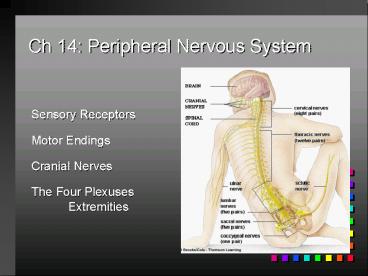Ch 14: Peripheral Nervous System PowerPoint PPT Presentation
1 / 39
Title: Ch 14: Peripheral Nervous System
1
Ch 14 Peripheral Nervous System
Sensory Receptors Motor Endings Cranial
Nerves The Four Plexuses Extremities
2
Review of Reflexes
- Fast, preprogrammed, inborn, automatic responses
- Occur in the CNS at the spinal cord or brainstem
levels - May be either monosynaptic or polysynaptic
- All require
- a. stimulus at receptor
- b. sensory information relay
- c. processing at CNS level
- d. activation of motor response
- e. response of peripheral effector
Fig 14.2
3
Peripheral Sensory Receptors
- Classified by
- Location
- Exteroceptors
- Interoceptors
- Proprioceptors
- Stimulus
- Thermoreceptors, etc.
- Structure
- Pacincian corpuscle
- Adaptive abilities
4
Peripheral Sensory Receptors, contd
- Free Nerve Endings
- Prominent in epithelia
- Pain and Temperature
- Light touch (Merkels discs)
5
Peripheral Sensory Receptors, contd
- Encapsulated Nerve Endings
- Meissners Corpuscles (Light Touch)
- Pacinian (lamellated) Corpuscles
- Throughout the Body
- Adaptive
- Mechanical Pressure
- Ruffinis Corpuscles
- Pressure and Touch
- Not very Adaptive
6
Proprioception
- Stretch Monitors detect position in space
- Modified muscle fibers (cells)
- Golgi tendon Organ
- Monitors tendon tension
- Knee Jerk Reflex is monosynaptic
- Joint Kinesthetic
- Joint Capsules
- All of the above types of receptors
7
The Other End (Effectors)
- Motor End Plate Similar to Synapse
- Skeletal Muscle
- ACh
- Broken down quickly, compared to nerve synapse
- Remember definition of Motor Unit
- Visceral (smooth) Muscle and Glands
- Varicosities
8
Peripheral Nerves (repetitio est)
Function sensory - afferent motor -
efferent mixed - contains axons of both
Definition bundles of axons. AKA tracts in CNS
Organization coverings (chapter
12) Epineurium wraps entire nerve Perineurium
wraps fascicles of tracts Endoneurium - wraps
individual axons
9
Anatomy of a Peripheral Nerve
10
Cranial Nerves
- Twelve pairs
- 2 attach to forebrain (Tel- Diencephalon)
- 10 attach to brainstem (Mes-, Met- and
Myelencephalon) - Names relate to appearance or function Classifica
tion Origin Destination
11
Olfactory Nerve ( CN or N I)
- C Sensory
- O Olfactory Epithelium in nasal cavity
- D Olfactory bulbs (by way of cribriform plate of
ethmoid) - Only CN directly attached to Cerebrum
12
Optic Nerve (N II)
- C Sensory
- O Retina
- D by way of optic foramen of sphenoid to
Diencephalon (optic chiasma) and to occipital
lobe
13
Oculomotor (N III)
- C Motor
- O Mesencephalon
- D Somatic motor to superior, inferior, medial
recti and inferior oblique visceral motor to
intrinsic eye muscles by way of superior orbital
fissure
14
Trochlear (N IV)
- C Motor
- O Mesencephalon
- D superior oblique muscle by way of superior
orbital fissure
15
Oculomotor (N III)
Trochlear Nerve (N IV)
Lateral view
16
Trigeminal (CN V)
- C Mixed
- three major branches
- 1. Ophthalmic (sensory)
- 2. Maxillary (sensory)
- 3. Mandibular (mixed)
- O face / nuclei of pons
- D sensory nuclei in pons / muscles of mastication
17
Abducens(CN VI)
C Motor O Pons D Lateral rectus eye muscle
18
Facial (CN VII)
Table 14.3
- C Mixed
- O sensory from taste receptors of anterior 2/3
of tongue / motor from pons - D Sensory to sensory nuclei of pons / motor
muscles of facial expression, visceral motor to
tear gland.
19
Facial (CN VII), contd
Bells Palsy
20
Vestibulocochlear (CN VIII)
- C Sensory
- O Receptors of inner Ear
- D Nuclei in Pons and medulla oblongata
- AKA acoustic nerve
21
Vestibulocochlear (CN VIII)
22
Glossopharyngeal (CN IX)
C mixed O sensory from posterior 1/3 of tongue
/ motor from medulla oblongata D medulla /
muscles for swallowing, parotid gland
23
Vagus (CN X)
- C Mixed
- O Sensation from pharyngeal area and outer ear /
motor from medulla - D Sensory to medulla / visceral (autonomic)
motor to thoracic and abdominal cavities and
their organs. Major motor pathway for ANS - Most important Cranial Nerve!
24
(No Transcript)
25
Accessory (CN XI) AKA Spinal Accessory
- C Motor
- O Motor nuclei of medulla and spinal cord
- D Swallowing, trapezius scm muscles
- Hypoglossal (N XII)
- C Motor
- O Motor nuclei of medulla
- D Tongue musculature
26
N XII
N XI
27
Mnemonic
Out On Our Table Top Are Fruits, Very Green
Veggies And Hamburgers
28
Spinal Nerves
- Sensory and Motor (of course)
- Through the Intervertebral Foramina
- Dermatomes
29
4 Principal Plexuses
- A blend, or network, of nerve fibers from several
spinal roots. - Cervical, includes Phrenic N.
- Brachial
- Lumbar
- Sacral
30
Cervical Plexus
Phrenic nerve - innervates diaphragm
31
Brachial Plexus
32
Nerves of the Arm
Musculocutaneous nerve innervates biceps and
brachialis muscles Median nerve - innervates
lateral flexors Ulnar nerve - innervates medial
flexors Radial nerve - innervates forearm
extensors
33
Lumbar Plexus
Femoral Nerve Lumbosacral Trunk (to Sciatic
Nerve) Obturator Nerve
34
Sacral Plexus
35
Nerves of the Leg
- Sciatic N.
- Thickest and Longest
- Branches to Tibial and Fibular Nerves
- Femoral N.
- Posterior aspect of leg
36
T-12
Narrow lumbar disk spaces result in pressure on
the spinal roots
L-5
37
The white oval is a postsurgical cyst or abscess
38
Shingles
- Varicella-zoster virus ( of the herpes family)
- In dorsal root ganglia and cranial nerves
- Initial infection chicken pox
39
(No Transcript)

